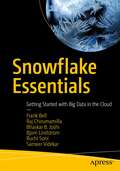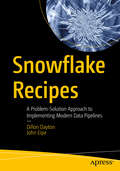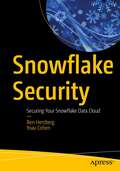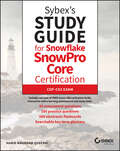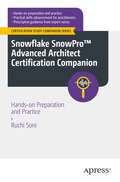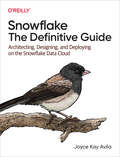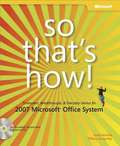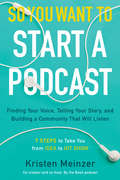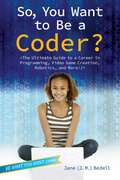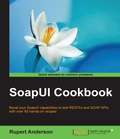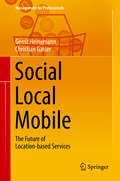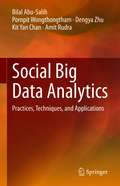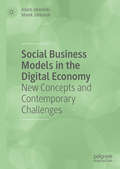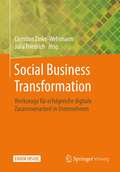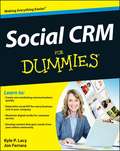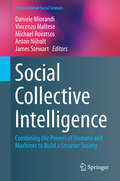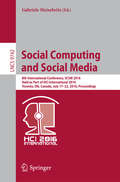- Table View
- List View
Snowflake Essentials: Getting Started with Big Data in the Cloud
by Frank Bell Raj Chirumamilla Bhaskar B. Joshi Bjorn Lindstrom Ruchi Soni Sameer VidekarUnderstand the essentials of the Snowflake Database and the overall Snowflake Data Cloud. This book covers how Snowflake’s architecture is different from prior on-premises and cloud databases. The authors also discuss, from an insider perspective, how Snowflake grew so fast to become the largest software IPO of all time.Snowflake was the first database made specifically to be optimized with a cloud architecture. This book helps you get started using Snowflake by first understanding its architecture and what separates it from other database platforms you may have used. You will learn about setting up users and accounts, and then creating database objects. You will know how to load data into Snowflake and query and analyze that data, including unstructured data such as data in XML and JSON formats. You will also learn about Snowflake’s compute platform and the different data sharing options that are available. What You Will LearnRun analytics in the Snowflake Data CloudCreate users and roles in SnowflakeSet up security in SnowflakeSet up resource monitors in SnowflakeSet up and optimize Snowflake ComputeLoad, unload, and query structured and unstructured data (JSON, XML) within SnowflakeUse Snowflake Data Sharing to share dataSet up a Snowflake Data ExchangeUse the Snowflake Data MarketplaceWho This Book Is ForDatabase professionals or information technology professionals who want to move beyond traditional database technologies by learning Snowflake, a new and massively scalable cloud-based database solution
Snowflake Recipes: A Problem-Solution Approach to Implementing Modern Data Pipelines
by Dillon Dayton John EipeExplore Snowflake’s core concepts and unique features that differentiates it from industry competitors, such as, Azure Synapse and Google BigQuery. This book provides recipes for architecting and developing modern data pipelines on the Snowflake data platform by employing progressive techniques, agile practices, and repeatable strategies. You’ll walk through step-by-step instructions on ready-to-use recipes covering a wide range of the latest development topics. Then build scalable development pipelines and solve specific scenarios common to all modern data platforms, such as, data masking, object tagging, data monetization, and security best practices. Throughout the book you’ll work with code samples for Amazon Web Services, Microsoft Azure, and Google Cloud Platform. There’s also a chapter devoted to solving machine learning problems with Snowflake. Authors Dillon Dayton and John Eipe are both Snowflake SnowPro Core certified, specializing in data and digital services, and understand the challenges of finding the right solution to complex problems. The recipes in this book are based on real world use cases and examples designed to help you provide quality, performant, and secured data to solve business initiatives. What You’ll Learn Handle structured and un- structured data in Snowflake. Apply best practices and different options for data transformation. Understand data application development. Implement data sharing, data governance and security. Who This book Is For Data engineers, scientists and analysts moving into Snowflake, looking to build data apps. This book expects basic knowledge in Cloud (AWS or Azure or GCP), SQL and Python
Snowflake Security: Securing Your Snowflake Data Cloud
by Ben Herzberg Yoav CohenThis book is your complete guide to Snowflake security, covering account security, authentication, data access control, logging and monitoring, and more. It will help you make sure that you are using the security controls in a right way, are on top of access control, and making the most of the security features in Snowflake. Snowflake is the fastest growing cloud data warehouse in the world, and having the right methodology to protect the data is important both to data engineers and security teams. It allows for faster data enablement for organizations, as well as reducing security risks, meeting compliance requirements, and solving data privacy challenges. There are currently tens of thousands of people who are either data engineers/data ops in Snowflake-using organizations, or security people in such organizations. This book provides guidance when you want to apply certain capabilities, such as data masking, row-level security, column-level security, tackling role hierarchy, building monitoring dashboards, etc., to your organizations. What You Will Learn Implement security best practices for SnowflakeSet up user provisioning, MFA, OAuth, and SSOSet up a Snowflake security modelDesign roles architectureUse advanced access control such as row-based security and dynamic maskingAudit and monitor your Snowflake Data Cloud Who This Book Is For Data engineers, data privacy professionals, and security teams either with security knowledge (preferably some data security knowledge) or with data engineering knowledge; in other words, either “Snowflake people” or “data people” who want to get security right, or “security people” who want to make sure that Snowflake gets handled right in terms of security
Snowflake SnowPro Core Certification Study Guide
by Hamid Mahmood QureshiPrepare smarter, faster, and better with the premier study guide for Snowflake SnowPro Core certification Snowflake, a cloud-based data warehousing platform, has steadily gained popularity since its 2014 launch. Snowflake offers several certification exams, of which the SnowPro Core certification is the foundational exam. The SnowPro Core Certification validates an individual's grasp of Snowflake as a cloud data warehouse, its architectural fundamentals, and the ability to design, implement, and maintain secure, scalable Snowflake systems. The Snowflake SnowPro Core Certification Study Guide delivers comprehensive coverage of every relevant exam topic on the Snowflake SnowPro Core Certification test. Prepare efficiently and effectively for the exam with online practice tests and flashcards, a digital glossary, and concise and easy-to-follow instruction from the subject-matter experts at Sybex. You'll gain the necessary knowledge to help you succeed in the exam and will be able to apply the acquired practical skills to real-world Snowflake solutions. This Study Guide includes: Comprehensive understanding of Snowflake's unique shared data, multi-cluster architecture Guidance on loading structured and semi-structured data into Snowflake Utilizing data sharing, cloning, and time travel features Managing performance through clustering keys, scaling compute up, down & across Steps to account management and security configuration including RBAC & MFA All the info you need to obtain a highly valued credential for a rapidly growing new database software solution Access to the Sybex online learning center, with chapter review questions, full-length practice exams, hundreds of electronic flashcards, and a glossary of key termsPerfect for anyone considering a new career in cloud-based data warehouse solutions and related fields, Snowflake SnowPro Core Certification Study Guide is also a must-read for veteran database professionals seeking an understanding of one of the newest and fastest-growing niches in data.
Snowflake SnowPro™ Advanced Architect Certification Companion: Hands-on Preparation and Practice (Certification Study Companion Series)
by Ruchi SoniMaster the intricacies of Snowflake and prepare for the SnowPro Advanced Architect Certification exam with this comprehensive study companion. This book provides robust and effective study tools to help you prepare for the exam and is also designed for those who are interested in learning the advanced features of Snowflake. The practical examples and in-depth background on theory in this book help you unleash the power of Snowflake in building a high-performance system. The best practices demonstrated in the book help you use Snowflake more powerfully and effectively as a data warehousing and analytics platform.Reading this book and reviewing the concepts will help you gain the knowledge you need to take the exam. The book guides you through a study of the different domains covered on the exam: Accounts and Security, Snowflake Architecture, Data Engineering, and Performance Optimization. You’ll also be well positioned to apply your newly acquired practical skills to real-world Snowflake solutions. You will have a deep understanding of Snowflake to help you take full advantage of Snowflake’s architecture to deliver value analytics insight to your business.What You Will LearnGain the knowledge you need to prepare for the examReview in-depth theory on Snowflake to help you build high-performance systemsBroaden your skills as a data warehouse designer to cover the Snowflake ecosystemOptimize performance and costs associated with your use of the Snowflake data platformShare data securely both inside your organization and with external partnersApply your practical skills to real-world Snowflake solutionsWho This Book Is ForAnyone who is planning to take the SnowPro Advanced Architect Certification exam, those who want to move beyond traditional database technologies and build their skills to design and architect solutions using Snowflake services, and veteran database professionals seeking an on-the-job reference to understand one of the newest and fastest-growing technologies in data
Snowflake: Architecting, Designing, and Deploying on the Snowflake Data Cloud
by Joyce Kay AvilaSnowflake's ability to eliminate data silos and run workloads from a single platform creates opportunities to democratize data analytics, allowing users at all levels within an organization to make data-driven decisions. Whether you're an IT professional working in data warehousing or data science, a business analyst or technical manager, or an aspiring data professional wanting to get more hands-on experience with the Snowflake platform, this book is for you.You'll learn how Snowflake users can build modern integrated data applications and develop new revenue streams based on data. Using hands-on SQL examples, you'll also discover how the Snowflake Data Cloud helps you accelerate data science by avoiding replatforming or migrating data unnecessarily.You'll be able to:Efficiently capture, store, and process large amounts of data at an amazing speedIngest and transform real-time data feeds in both structured and semistructured formats and deliver meaningful data insights within minutesUse Snowflake Time Travel and zero-copy cloning to produce a sensible data recovery strategy that balances system resilience with ongoing storage costsSecurely share data and reduce or eliminate data integration costs by accessing ready-to-query datasets available in the Snowflake Marketplace
So Much I Want to Tell You: Letters to My Little Sister
by Anna AkanaFrom Internet sensation Anna Akana comes a candid and poignant collection of essays about love, loss, and chasing adulthood. In 2007, Anna Akana lost her teen sister, Kristina, to suicide. In the months that followed, she realized that the one thing helping her process her grief and begin to heal was comedy. So she began making YouTube videos as a form of creative expression and as a way to connect with others. Ten years later, Anna has more than a million subscribers who watch her smart, honest vlogs on her YouTube channel. Her most popular videos, including “How to Put On Your Face” and “Why Girls Should Ask Guys Out,” are comical and provocative, but they all share a deeper message: Your worth is determined by you and you alone. You must learn to love yourself. In So Much I Want to Tell You, Anna opens up about her own struggles with poor self-esteem and reveals both the highs and lows of coming-of-age. She offers fresh, funny, hard-won advice for young women on everything from self-care to money to sex, and she is refreshingly straightforward about the realities of dating, female friendship, and the hustle required to make your dreams come true. This is Anna’s story, but, as she says, it belongs just as much to Kristina and to every other girl who must learn that growing up can be hard to do. Witty and real, Anna breaks things down in a way only a big sister can.Advance praise for So Much I Want to Tell You“This book is filled with the kind of honesty, vulnerability, and determination that makes Anna such a captivating person. One warning: You’ll want to hug her a lot while reading this.”—Natalie Tran, actress and comedian “As a woman working in entertainment, Anna Akana is accustomed to feeling vulnerable. Which means that she’s used to being brave. This book is a tribute to the duality of bravery and fear as told through Anna’s experiences to date.”—Hannah Hart, New York Times bestselling author of Buffering: Unshared Tales of a Life Fully Loaded “Frank advice on how to live a productive, happy life . . . written in tribute to a ‘fearless, talented, and bold’ sister.”—Kirkus Reviews
So That's How! 2007 Microsoft® Office System: Timesavers, Breakthroughs, & Everyday Genius
by Evan Archilla Tiffany SongvilayTurn your productivity drains into productivity gains! With this practical (and fun) guide, you'll discover the best ways to tackle your daily work with the 2007 Microsoft Office system. The authors have taught thousands of people to get better results with less effort. Now these efficiency experts let you steal from their "tip jar" full of timesaving shortcuts and other brilliant ideas. You'll explore what's new in your favorite Microsoft Office programs--and transform the way you work. Get timesavers, breakthroughs, & everyday genius to: Take control of your inbox, calendar, and everyday information deluge Create stunning documents that leave them asking "How'd you do that?" Make meetings less frustrating and more productive for everyone Change the way you capture, share, and act on digital notes Simplify document sharing--and make collaboration painless Find new ways to boost your mobile productivity PLUS--See "Tips & Tricks" in action on CD. Get 20 videos from the authors' popular training series! A Note Regarding the CD or DVD The print version of this book ships with a CD or DVD. For those customers purchasing one of the digital formats in which this book is available, we are pleased to offer the CD/DVD content as a free download via O'Reilly Media's Digital Distribution services. To download this content, please visit O'Reilly's web site, search for the title of this book to find its catalog page, and click on the link below the cover image (Examples, Companion Content, or Practice Files). Note that while we provide as much of the media content as we are able via free download, we are sometimes limited by licensing restrictions. Please direct any questions or concerns to booktech@oreilly.com.
So You Want to Start a Podcast: Finding Your Voice, Telling Your Story, and Building a Community That Will Listen
by Kristen MeinzerAn inspiring, comprehensive, step-by-step guide to creating a hit show, So You Want to Start a Podcast covers everything from hosting and guest booking to editing and marketing - while offering plenty of encouragement and insider stories along the way. Though they are the fastest-growing form of media, podcasts can actually be tricky to create—and even harder to sustain. Few know the secrets of successfully creating a knockout podcast better than Kristen Meinzer. An award-winning commentator, producer, and former director of nonfiction programming for Slate’s sister company, Panoply, Meinzer has also hosted three successful podcasts, reaching more than ten million listeners. Now, she shares her expertise, providing aspiring podcasters with crucial information and guidance to work smarter, not harder as they start their own audio forum.Meinzer believes that we each have a unique voice that deserves to be heard. But many of us may need some help transforming our ideas into reality. So You Want to Start a Podcast asks the tough but important questions to help budding podcasters define and achieve their goals, including:Why do you want to start a podcast? Think about specifically why you want to start a podcast versus a blog, zine, YouTube channel, Instagram feed, or other media outlet. Find out if a podcast is really the best way to tell your story—and what you really need (and don’t need!) in order to get started.What is your show about? For any advertiser, corporate partner, or press outlet, you need a snappy pitch. How would you describe what you want to do in two to three sentences?Who is your podcast for? Who are you trying to reach? How will your content and tone appeal to those listeners?How is your show going to be structured? Create a step-by-step map planning the show out. Think about length, segments, interviews, advice, news reads, and other aspects of successful podcasts you can adapt for your own.With this motivational how-to guide—the only one on the subject available—you’ll find the smart, bottom-line advice and inspiration you need to produce an entertaining and informative podcast and promote it to an audience that will love it. So You Want to Start a Podcast gives you the tools you need to start a podcast—and the insight to keep it thriving!
So You Want to Work in Crypto: Not Law, Not Medicine, But Crypto
by Alexander Rees-EvansGain the necessary technical skills, tools, and insights to succeed in the crypto working environment. Changing market conditions have created new opportunities and working conditions. This book goes beyond just getting a job, as it shares a myriad of hidden tips on how to thrive within this constantly evolving ecosystem. Through examples and detailed typologies, you’ll work out which crypto job is the best fit for you. You’ll begin by reviewing some fun facts and anecdotes illustrating life in a Web3 environment, with a careful examination of the various roles in crypto, blockchain, and digital assets. You’ll then compare roles in the traditional corporate and financial environments with those in the crypto world from a risk and reward perspective. From there you’ll prepare for crypto job interviews with a focus on what to expect and fine-tuning the necessary expertise to excel. Different types of contracts, the onboarding process, communication tools, the intricacies of video conferences, internal storage, and various crypto-specific operational skills will all be clearly explained as well. So You Want to Work in Crypto provides all the strategies you’ll need to stay ahead of the curve in the ever-changing crypto world. What You'll Learn Examine what job positions exist in Web3 and how to obtain the right one for you. Prepare yourself for the Web3 environment and the type of job you will get. See how to strategically evolve your career in the world of crypto. Who This Book Is For Any individual curious about evolving their career, obtaining their first job, or simply looking to find a new, more fulfilling job in an exciting revolutionary industry.
So geht Digital Marketing: Tools, Tipps und Trends für die Praxis
by Claudia BünteDieses Buch bietet Ihnen einen umfassenden und praxisorientierten Leitfaden, die Welt des digitalen Marketings zu verstehen. Erfahren Sie, wie und mit welchen digitalen Tools Sie heute Consumer Insights gewinnen, analysieren und präsentieren können. Lernen Sie, Datenbanken aufzubauen und zu nutzen. Entwickeln und managen Sie erfolgreich Marken mit digitalen Werkzeugen. Setzen Sie Textgenerierung, Bildgestaltung und Videobearbeitung ein, um Werbung effizient und effektiv zu steuern und Ihre Erfolge messbar machen.Wie wird außerdem die Arbeitswelt der Marketing-ManagerInnen in Zukunft aussehen und welche Rolle spielen dabei die digitale Transformation, neuartige Analyseinstrumente und künstliche Intelligenz? Die Autorin hat für Sie eine umfassende und praxisorientierte Anleitung zusammengestellt, um im digitalen Marketing erfolgreich zu sein. Ein unverzichtbares Handbuch für MarketingexpertInnen, UnternehmerInnen, Studierende und für alle, die ihr Wissen über digitales Marketing erweitern wollen.Der InhaltWas ist Digital Marketing und wie helfen KI- und andere digitale ToolsConsumer Insights: So verstehen Sie KundInnen wirklichMarken- und Marketingstrategie: So definieren Sie, was Sie erreichen wollen und wie Sie das schaffenExekution: So gelingt Ihnen eine effektive und effiziente WerbungPerformance Management: So messen Sie den Erfolg Ihres MarketingsAusblick: So geht es in Zukunft im Marketing weiter und darauf sollten Sie sich einstellenClaudia Bünte konnte Gastbeiträge von folgenden Autoren für das Buch, gewinnen und erläutert deren besonderen Wert wie folgt:Meinert Jacobsen, der die außergewöhnliche Gabe hat, Werbung und Kommunikation mit harten Zahlen zu kombinieren, daraus Firmen zu gründen und zu leiten und seine Erfahrungen an andere so weiterzugeben, dass sie interessant und lesenswert sind. Er ist Leiter des Kompetenz-Centers „Künstliche Intelligenz und Customer Centric“ des DDV (Deutschen Dialogmarketing Verbandes) und aktiv im Vorstand der AIKA (Allianz inhabergeführter Kommunikationsagenturen).Jan Donaj, für seine gute und einfach verständliche Erläuterung zu Online-Marketing – aus der Praxis für die Praxis sozusagen. Jan ist außerdem in meinem wissenschaftlichen Team an der Hochschule zu „KI im Marketing“ und erläutert uns auch hier immer wieder, welche neuen Tools es gibt. Dr. Peter Petermann, Wunderman Thompson Switzerland AG, der seit vielen Jahren leitende Funktionen in der Mediastrategie innehat – und ein hervorragendes Buch („Marke und Gedächtnis“) zur Markenführung geschrieben hat. Darin erklärt er kurzweilig und mit vielen Beispielen, was ein Consumer Insight genau ist und wie man daraus Kampagnen entwickelt. Sascha Stürze, mit dem ich viele Projekte zu Marketing Return on Investment (ROI) für verschiedene KundInnen aufgesetzt und durchgeführt habe. Saschas Fähigkeiten, immer das große Ganze für die KlientInnen im Blick zu behalten, obwohl seine Teams ständig im kleinsten Datendetail arbeiten, ist bemerkenswert. Wer mehr zu ROI und die organisatorischen und methodischen Erfolgsfaktoren von data-driven Marketing lesen will, der findet pragmatische Anregungen in Saschas neustem Buch „Agile Marketing Performance Management“
So werden wir lernen!
by John Erpenbeck Werner SauterWie werden wir in zehn Jahren beruflich - betrieblich lernen? In welcher Weise werden wir dann die vielfältigen neuen Möglichkeiten der Lerntechnologie und des sozialen Lernens im Web nutzen, die sich schon heute andeuten? In den kommenden zehn Jahren werden Computer zu aktiven Lernpartnern, die Kompetenzentwicklungsprozesse ermöglichen und tutoriell begleiten. Dabei sind drei Trends von wesentlicher Bedeutung: * Die Entfaltung semantischer Netze im Rahmen von Kompetenzentwicklungsprozessen, * die zunehmende Einbeziehung des Cloud Computing in betriebliche Lernsysteme, * die Nutzung immer leistungsfähigerer "humanoider" Computer als Tandempartner beim selbstorganisierten Kompetenzaufbau. Die Autoren analysieren diese Entwicklungen. Sie leiten Trends für das Lernen in der Zukunft ab und entwickeln Anwendungsvorschläge für die Kompetenzentwicklung mit dem "Lernpartner Computer". Sie prognostizieren, wie sich Lernräume und Lernkulturen in Unternehmen schrittweise auf diese kommenden Veränderungen hin entwickeln werden und leiten daraus konkrete Handlungsempfehlungen für die Gestaltung der aktuellen Lernsysteme ab.
So, You Want to Be a Coder?: The Ultimate Guide to a Career in Programming, Video Game Creation, Robotics, and More!
by Jane J. BedellLove coding? Make your passion your profession with this comprehensive guide that reveals a whole host of careers working with code.Behind the screen of your phone, tablet, computer, or game console lies a secret language that allows it all to work. Computer code has become as integral to our daily lives as reading and writing, even if you didn't know it! Now it's time to plug in and start creating the same technology you're using every day. Covering everything from navigating the maze of computer languages to writing code for games to cyber security and artificial intelligence, So, You Want to Be a Coder? debugs the secrets behind a career in the diverse and state-of-the-art industry. In addition to tips and interviews from industry professionals, So, You Want to Be a Coder? includes inspiring stories from kids who are working with code right now, plus activities, a glossary, and helpful resources to put you on the path to a fun and rewarding career with computer code today!
SoLoMo - Always-on im Handel
by Gerrit Heinemann Christian W. GaiserDieses Fachbuch zeigt auf, welches Potenzial das mobile Internet für den stationären Handel darstellt. Das Shopping der Zukunft zeichnet sich durch ein begleitendes Zusammenspiel von sozialer Vernetzung, Lokalisierung und mobiler Internetnutzung beim Ladenbesuch aus. Dieser Dreiklang bildet die Basis für die ,,Synergien des SoLoMo", die neue Möglichkeiten der Vermarktungseffizienz - insbesondere für stationäre Händler - erschließen. Die Autoren greifen die sich daraus ergebenden Chancen auf, indem sie den aktuellen Stand der Forschung und Praxis zu dem Thema darstellen und die Basisfaktoren des SoLoMo umfassend klären. Dabei werden die Location-based Services (LBS), denen eine Schlüsselrolle im Handel der Zukunft zukommt, besonders gewichtet und mit einer empirischen Studie in Hinblick auf Nutzung sowie Potenzial erforscht. Neu in der 3. Auflage Die repräsentative Verbraucherbefragung von kaufDA und den beiden Autoren zum Thema ,,Mobiles Internet fördert die Wiederentdeckung des stationären Handels" wurde 2015 im Zeitreihenvergleich gegenüber 2013 und 2014 wiederholt. Sie zeigt den aktuellen Stand der Smartphone-Nutzung 2015. Zahlen, Daten, Fakten und Best Practices wurden aktualisiert. Der Inhalt Always-on und Always-in-Touch - das neue Kaufverhalten Social Commerce als Basisfaktor Nr. 1 des SoLoMo Location-based Services als Basisfaktor Nr. 2 des SoLoMo Mobile Commerce als Basisfaktor Nr. 3 des SoLoMo Empirische Studie von kaufDA - Status und Potenziale von Location-based Services
SoLoMo - Always-on im Handel
by Gerrit HeinemannDas Shopping der Zukunft zeichnet sich durch ein begleitendes Zusammenspiel von sozialer Vernetzung, Lokalisierung und mobiler Internetnutzung beim Ladenbesuch aus. Dieser Dreiklang bildet die Basis für die ,,Synergien des SoLoMo", die ganz neue Möglichkeiten der Vermarktungseffizienz insbesondere für stationäre Händler erlauben. Die sich daraus ergebenden Chancen greift das vorliegende Buch auf, indem es den aktuellen Stand der Forschung und Praxis zu dem Thema darstellt und die Basisfaktoren des SoLoMo umfassend klärt. Dabei werden die Location Based Services (LBS), denen eine Schlüsselrolle im Handel der Zukunft zukommt, besonders gewichtet und mit einer empirischen Studie in Hinblick auf Nutzung sowie Potenzial am Beispiel von kaufDA erforscht. Die Ergebnisse weisen darauf hin, dass die Kunden LBS als attraktiv ansehen und bereit sind, durch sie habitualisiertes Einkaufsverhalten in Frage zu stellen. LBS befinden sich allerdings noch im Anfangsstadium und sind vom Begriff her relativ unbekannt, lassen allerdings große Potenziale erkennen.
SoapUI Cookbook
by Rupert AndersonThis book is aimed at developers and technical testers who are looking for a quick way to take their SoapUI skills and understanding to the next level. Even if you are new to SoapUI but have basic Java skills and a reasonable grasp of RESTFul and Soap web services, then you should have no problem making use of this book.
Sobreviviendo a la IA: La promesa y el peligro de la Inteligencia Artificial
by Calum ChaceEste es el siglo de las dos singularidades: la singularidad económica (desempleo tecnológico) y la singularidad tecnológica (la explosión de la inteligencia). Ambas presentan enormes oportunidades y enormes desafíos. Si las manejamos con éxito, nuestro futuro como especie será más que maravilloso. Si fallamos, podría ser miserable, y quizás breve. El impulsor es la inteligencia artificial (IA), la tecnología más poderosa de la humanidad. El software que resuelve problemas y convierte los datos en valiosa información ya ha revolucionado nuestras vidas, y la revolución se está acelerando. En 2015, la inteligencia artificial ocupaba las primeras planas, y con justa razón. Se está acercando a un punto de inflexión en el que las máquinas pueden realizar mejor que nosotros muchas tareas que antes se consideraban exclusivamente humanas. Los sistemas de aprendizaje profundo están a punto de reconocer imágenes y comprender el lenguaje natural mejor que los humanos. El argumento de este libro es que debemos monitorear los cambios que están ocurriendo y adoptar políticas que fomenten los mejores resultados posibles. La gama de posibles resultados es amplia, desde los terribles hasta los maravillosos, y no están predeterminados. Serán seleccionados en parte por suerte, en parte por su propia lógica interna, pero en parte también por las políticas adoptadas en todos los niveles de la sociedad. La automatización y la superinteligencia son los dos desarrollos que ya podemos prever causarán grandes impactos. La automatización podría conducir a una singularidad económica y la evolución a un tipo de economía completamente diferente. Si nos equivocamos, una élite podría poseer los medios de producción y reprimir al resto de nosotros en un autoritario régimen tecnológico distópico. Si lo hacemos bien, podríamos disfrutar de una economía de abundancia radical, donde nadie tiene que trabajar para ganarse la vida, y todos somos libres para divert
Social - Local - Mobile
by Gerrit Heinemann Christian Gaisern the future, shopping will be greatly influenced by a combination of localization issues, mobile internet at the point of sale, and use of social networks. This book focuses on the 'SoLoMo synergies' that arise from this paradigm shift in future shopping, which also promises new and effective marketing options for traditional retailers. It also reflects the current status of research and business practice, analyzing the basic factors of SoLoMo in detail. The importance of Location-based Services (LBS) is elaborated and analyzed in an empirical study using a market based case of kaufDA - a leading German online shopping network. The evidence shows that customers see LBS as an attractive tool and are prepared to change their buying behavior. Though LBS is still in its early stages and its professional longevity remains to be seen, it also promises tremendous potential for the future.
Social Big Data Analytics: Practices, Techniques, and Applications
by Pornpit Wongthongtham Bilal Abu-Salih Dengya Zhu Kit Yan Chan Amit RudraThis book focuses on data and how modern business firms use social data, specifically Online Social Networks (OSNs) incorporated as part of the infrastructure for a number of emerging applications such as personalized recommendation systems, opinion analysis, expertise retrieval, and computational advertising. This book identifies how in such applications, social data offers a plethora of benefits to enhance the decision making process.This book highlights that business intelligence applications are more focused on structured data; however, in order to understand and analyse the social big data, there is a need to aggregate data from various sources and to present it in a plausible format. Big Social Data (BSD) exhibit all the typical properties of big data: wide physical distribution, diversity of formats, non-standard data models, independently-managed and heterogeneous semantics but even further valuable with marketing opportunities.The book provides a review of the current state-of-the-art approaches for big social data analytics as well as to present dissimilar methods to infer value from social data. The book further examines several areas of research that benefits from the propagation of the social data. In particular, the book presents various technical approaches that produce data analytics capable of handling big data features and effective in filtering out unsolicited data and inferring a value. These approaches comprise advanced technical solutions able to capture huge amounts of generated data, scrutinise the collected data to eliminate unwanted data, measure the quality of the inferred data, and transform the amended data for further data analysis. Furthermore, the book presents solutions to derive knowledge and sentiments from BSD and to provide social data classification and prediction. The approaches in this book also incorporate several technologies such as semantic discovery, sentiment analysis, affective computing and machine learning.This book has additional special feature enriched with numerous illustrations such as tables, graphs and charts incorporating advanced visualisation tools in accessible an attractive display.
Social Business Models in the Digital Economy: New Concepts and Contemporary Challenges
by Adam Jabłoński Marek JabłońskiFilling a gap in the current literature, this book addresses the social approach to the design and use of innovative business models in the digital economy. It focuses on three areas that are of increasing importance to businesses and industry today: social issues and sustainability; digitization; and new economic business models, specifically the sharing and circular economies. The authors aim to solve current scientific concerns around the conceptualization and operationalization of social business models, addressing management intentions and the impact of these models on society. Based on observation of social phenomena and the authors' research and practical experience, the book highlights best practices for designing and assessing social business models.
Social Business Transformation: Werkzeuge für erfolgreiche digitale Zusammenarbeit in Unternehmen
by Julia Friedrich Christian Zinke-WehlmannDie Zukunft der Arbeit verlagert sich zunehmend in den digitalen Raum. Deutsche Unternehmen positionieren sich in der Gestaltung dieses Raumes bislang häufig in der Rolle der Nachzügler, weil sie die Bedeutung des Einsatzes sozialer Technologien (z.B. Enterprise Social Networks) für das Unternehmen unterschätzen. Das resultierende Risiko im globalen Wettbewerb unterzugehen, ist gerade für den Mittelstand erheblich.Um zukunftsfähige Wege einzuschlagen, braucht es neue Gestaltungsansätze. Einer davon ist Social Business. Social Business wird im vorliegenden Werk als ganzheitliches Konzept beschrieben, welches durch den systematischen Einsatz digitaler und kollaborativer Werkzeuge neue Möglichkeiten der Innovation und Wertschöpfung schafft. Soziale Technologien ermöglichen eine proaktive Gestaltung unternehmensinterner und -übergreifender Prozesse und bieten insbesondere im Wissensmanagement, in der Kommunikation sowie der Zusammenarbeit produktionssteigernde Potenziale.Im Rahmen dieses Werkes werden praktische Anwendungen, Konzepte zur Umsetzung von Social Business und Leitlinien für den Transformationsprozess wissenschaftlich fundiert und praxisnah präsentiert.
Social CRM For Dummies
by Stephanie Diamond Kyle Lacy Jon FerraraDiscover great ways to engage your customers through the social webSocial CRM is an evolving tool to help you engage your customers, interact with them, and develop deeper relationships. This handy guide teaches you how to make the most of it, whether your business is a small shop or a large corporation. In a friendly, easy-to-understand style, it explains how you can create new marketing communications and develop smart, applicable content that produces results from your online community. You'll learn to use data to drive results, create social Key Performance Indicators for different business units, and a great deal more.Today's consumer uses technology to select relationships with companies; this book teaches business owners how to use social CRM to create relationships that customers want to maintainExplains how to integrate social media into your CRM mix Shows how to use data and information gathered through social sites Helps you develop social KPIs and create content that gets results from your online communitySocial CRM For Dummies helps businesses large and small use social media to develop and maintain productive customer relationships.
Social Collective Intelligence
by James Stewart Anton Nijholt Daniele Miorandi Vincenzo Maltese Michael RovatsosThe book focuses on Social Collective Intelligence, a term used to denote a class of socio-technical systems that combine, in a coordinated way, the strengths of humans, machines and collectives in terms of competences, knowledge and problem solving capabilities with the communication, computing and storage capabilities of advanced ICT. Social Collective Intelligence opens a number of challenges for researchers in both computer science and social sciences; at the same time it provides an innovative approach to solve challenges in diverse application domains, ranging from health to education and organization of work. The book will provide a cohesive and holistic treatment of Social Collective Intelligence, including challenges emerging in various disciplines (computer science, sociology, ethics) and opportunities for innovating in various application areas. By going through the book the reader will gauge insight and knowledge into the challenges and opportunities provided by this new, exciting, field of investigation. Benefits for scientists will be in terms of accessing a comprehensive treatment of the open research challenges in a multidisciplinary perspective. Benefits for practitioners and applied researchers will be in terms of access to novel approaches to tackle relevant problems in their field. Benefits for policy-makers and public bodies representatives will be in terms of understanding how technological advances can support them in supporting the progress of society and economy.
Social Commerce verstehen – Chancen erkennen: Strategien, Checklisten und Tools für erfolgreiches Social Selling
by Markus H. Dahm Philipp DornachDieses Buch erläutert die Mechanismen, die hinter erfolgreichem Social Commerce stehen. Dabei werden die folgenden zentralen Fragen beantwortet: Was motiviert Menschen, auf Instagram, TikTok oder Facebook zu kaufen? Welche Rolle spielen Influencer, Bewertungen und Communities? Und wie können Unternehmen diese Dynamiken nutzen, ohne ihre Glaubwürdigkeit und Autonomie zu verlieren? Likes und Follower sind schnell gesammelt – doch echtes Vertrauen aufzubauen, ist eine viel anspruchsvollere Aufgabe. Wer in Social Media erfolgreich verkaufen möchte, muss mehr können als Werbeanzeigen schalten. Bei Social Commerce geht es nicht allein um datengetriebene Optimierung, sondern um das gezielte Initiieren, Moderieren und Nutzen sozialer Stimmungen, um durch Kreativität echten Mehrwert zu schaffen. Die Fähigkeit, relevante Inhalte emotional aufzuladen, Gespräche zu ermöglichen und sich als glaubwürdiger Teil einer Community zu positionieren, ist dabei unabdingbar.
Social Computing and Social Media
by Gabriele MeiselwitzThis book constitutes the refereed proceedings of the 7th International Conference on Social Computing and Social Media, SCSM 2015, held as part of the 17th International Conference on Human-Computer Interaction, HCII 2015, held in Los Angeles, CA, USA, in August 2015. The total of 1462 papers and 246 poster papers presented at the HCII 2015 conferences was carefully reviewed and selected from 4843 submissions. These papers address the latest research and development efforts and highlight the human aspects of design and use of computing systems. The papers accepted for presentation thoroughly cover the entire field of human-computer interaction, addressing major advances in knowledge and effective use of computers in a variety of application areas. The 25 contributions included in the SCSM 2015 proceedings were organized in the following topical sections: designing social media; social network analysis; and individual and group behaviour in social media.
